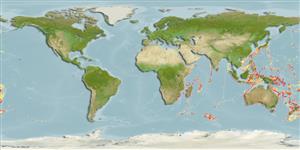>
Anguilliformes (Eels and morays) >
Colocongridae (Short-tail eels)
Etymology: Coloconger: Greek, kolos = short, truncated + Latin conger = conger (Ref. 45335).
Environment: milieu / climate zone / depth range / distribution range
Ökologie
seewasser bathydemersal; tiefenbereich 412 - 970 m (Ref. 86942). Deep-water
Indo-Pacific: southern Mozambique and Natal, South Africa, but probably much more widespread, also South China Sea and east Australia.
Size / Gewicht / Alter
Maturity: Lm ? range ? - ? cm
Max length : 51.0 cm TL Männchen/unbestimmt; (Ref. 5323)
Kurzbeschreibung
Morphologie | Morphometrie
Wirbelzahl: 142 - 157. Dark blackish brown.
Inhabits deep waters (Ref. 5213).
Life cycle and mating behavior
Geschlechtsreife | Fortpflanzung | Ablaichen | Eier | Fecundity | Larven
Castle, P.H.J., 1986. Congridae. p. 161-165. In M.M. Smith and P.C. Heemstra (eds.) Smiths' sea fishes. Springer-Verlag, Berlin. (Ref. 5323)
IUCN Rote Liste Status (Ref. 130435)
Bedrohung für Menschen
Harmless
Nutzung durch Menschen
Mehr Information
NamenSynonymeMetabolismusRäuberÖkotoxikologieFortpflanzungGeschlechtsreifeAblaichenSpawning aggregationFecundityEierEientwicklung
ReferenzenAquakulturAquakultur ProfilZuchtlinienGenetikElectrophoresesVererbbarkeitKrankheitenVerarbeitungNutrientsMass conversion
PartnerBilderStamps, Coins Misc.LauteCiguateraGeschwindigkeitSchwimmstilKiemenoberflächeOtolithsGehirngrößeSehfähigkeit
Tools
Zusatzinformationen
Download XML
Internet Quellen
Estimates based on models
Preferred temperature (Ref.
123201): 2.2 - 10.3, mean 7.8 °C (based on 421 cells).
Phylogenetic diversity index (Ref.
82804): PD
50 = 0.5156 [Uniqueness, from 0.5 = low to 2.0 = high].
Bayesian length-weight: a=0.00110 (0.00043 - 0.00280), b=3.13 (2.91 - 3.35), in cm total length, based on LWR estimates for this (Sub)family-body shape (Ref.
93245).
Trophic level (Ref.
69278): 3.8 ±0.6 se; based on size and trophs of closest relatives
Fishing Vulnerability (Ref.
59153): Moderate vulnerability (40 of 100).
